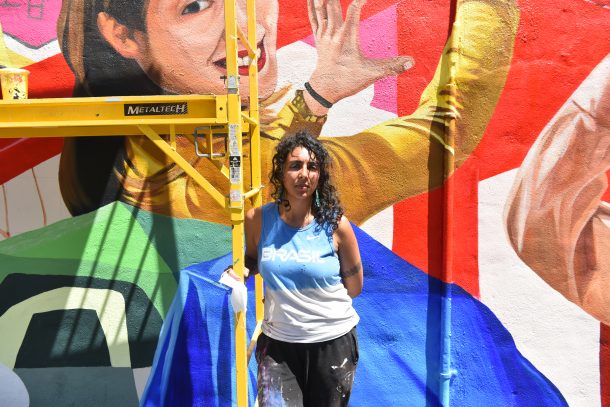Guest artist Priya Handa comes highly recommended. A member of the Precita Eyes families, she comes to the “AscenDance” mural as a veteran of community mural projects throughout California and internationally. Watching her work on this mural is a study in quiet — yet intense — focus and concentration. Although she professes to be more comfortable with brushes than with words, she has an amazing story (or three) to tell about her experiences painting in other countries, how she communicates visually, and the connection between murals and movements. Read all about Handa in the latest installment of Meet the Muralist. (If you missed the first in the series, you can catch it here.)
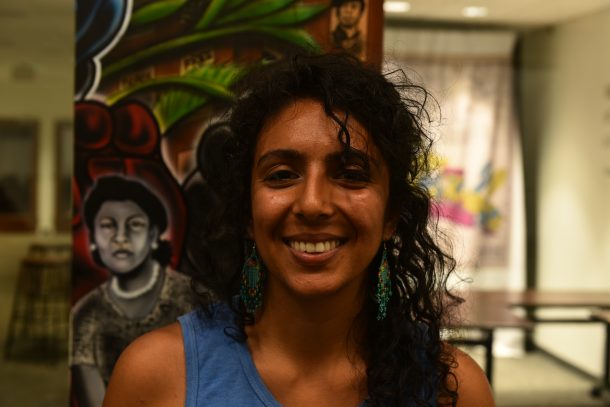
-Priya Handa
“Art takes up space. If you’re doing mural work or doing murals on the floor, it physically takes up space. Eventually it takes up space in the system.”
CRP: Where are you from originally?
Priya Handa: I was born in the Bay. I grew up around San Jose and Oakland. I used to come out and see my grandfather a lot in Oakland. And then I was working in San Jose and San Francisco a lot in my upbringing. I grew up around the bay primarily. Both my parents are immigrants. They both migrated from Punjab.
Punjab, that’s a state in India?
Yeah. It is in-between , it’s where the partition happened. So between Pakistan and India. It’s part of the northern part of India. It has a lot of controversy, experiences with genocide.
It’s a historic conflict zone.
Yeah. It definitely is.
So did your parents come as refugees?
Not necessarily as refugees. I think the story is something they don’t really like to share personally. I’ve asked so many times. But I think my own understanding of history, of where they’re from, I think it’s a lot of trauma for them too, especially because during the time we did migrate, we had one of the largest genocides, and at the same time, being Punjabi and being Sikh, we don’t really get recognized by the Indian government, because it’s primarily a Hindu state.
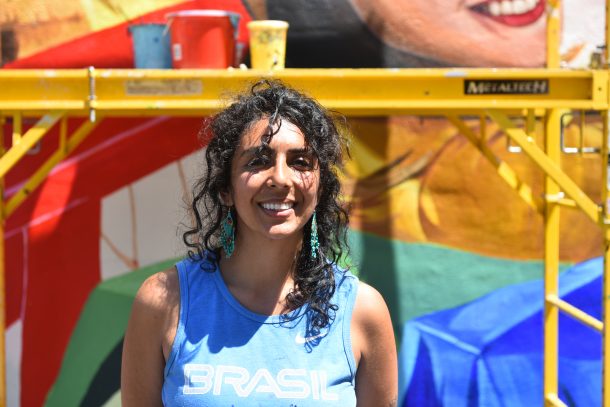
-Priya Handa
“Murals are the best way, in my opinion, for people to be included.”
How did you get interested in art?
I feel like, always. Like, I remember being like one and taking my mom’s lipstick and drawing on the wall. I think that was probably the first time. Growing up with an immigrant family, you don’t really know a lot about American culture. From games to cable and like, what to do outside besides play outside. So drawing was a huge thing for me. I think creating was a huge thing for me. I grew up watching my mom sew a lot, like she sewed all her clothes. Indian clothes to American clothes, sofas, couches. And I watched my dad build a lot. I think watching that made me think really traditional, like, you can do anything by hand. I think that’s why art has always been really great for me, from sketching to painting to whatever format I can get on.
How did you become a muralist?
Growing up, painting, and then finally taking it more seriously. You know, when you’re a kid you get to win little contests or you get to submit something and you don’t think too much of it. When I got older, I started selling work and not thinking too much of it, either. But there was a point where I was like, I feel like there’s a divide. There’s a divide between people who show in galleries and people that are able to actually view it. So, wanting my art to be as inclusive as possible and then I growing up, watched throughout California, LA has a big mural culture. The Bay Area has a big mural culture. Murals were the best way, in my opinion, for people to be included. You know, you get to watch the process, if you’re outside, and it allows people from different socioeconomic backgrounds to be able to see and witness it. Whereas like, not even to put down galleries, but it just made it limited.

To go see gallery art, it’s more intentional. Like, I’m going to see Picasso at the DeYoung. Not like, I’m gonna walk down 14th Street, and just see what’s in front of me.
Art’s a universal language, whether you know how to speak the same language or not.
Like Marina Perez-Wong and Elaine Chu, you’ve been involved with Precita Eyes. How did you get involved with them?
I was painting a lot more in Oakland and Berkeley, and a little bit in LA. And then I worked with some of the folks like Nancy (Pili) from Trust Your Struggle and Susan Greene, and I remember there was an ask from some Precita gigs in the Mission and I said, well, maybe I’ll just go and volunteer. Through that, I learned a lot about how to set up for a mural, how to grid, how to kind of project a design. How to do everything but the painting part, which is huge. From that, I think I learned a lot of skills it would have taken me years and years and years to learn on my own. And also how a community mural is done and how to get feedback from the whole community and include them.
So there’s a lot of technical stuff that comes with doing a mural — it’s not just, painting.

-Priya Handa
“If you’ve ever seen a mural for Palestine, you’re gonna see a lot more blacks and reds and fists and chains… That’s not what Palestinians want to see, because that’s their existence. They want to see skies, birds, their grandmother holding bread.”
You’re right. It’s not just painting. There’s a saying, once the paint hits the wall, the mural’s 50% done. Which I think if you grid a mural, or do sketches, or work with community members, you’ll see what that really means.
Tell me again about your experiences painting internationally in Chiapas and Palestine. What was that like and what did you learn from those experiences?
When I was in Chiapas, I painted with the Zapatista community out there. And of course, there was a lot to learn from that community. Especially for us who live in the US. There’s a lot to learn about autonomy and different forms of education. And so when I was painting out there one of the things that struck me was someone brought donations — crayons, pens, notebooks — and it was like, oh we don’t need this. We teach our kids how to tell from a lightning storm if we’re gonna have rain, or what’s gonna happen. And so the mural actually was used as an educational tool for the students there, as opposed to handing out notebooks. So that was really cool to see the art that resonated with them. And how the mural was used as a tool, as opposed to something that’s just used as decoration, just to fill a space. It was also cool to see it was something with purpose.
So it seems like it was practical, but also cultural.
Yeah, definitely. There was a lot we learned about how they do different things culturally, from agriculture to, one of my favorite things was drawing the stages of the butterflies and what that represented for them.
What does that represent?

There’s different things for sure. Like they talked about the stages of the butterfly. Like from caterpillar to going into the stages of the butterfly. I remember one person telling me, whenever you see a butterfly it means that an ancestor is coming through to visit you. That’s one interpretation I remember learning from someone when we were painting out there.
What about Palestine? What happened when you were out there?
When we were out there, I went on a delegation actually first. And then towards the end of it, I met up with Susan Greene, who does ArtForces, and she’s the one who I met through the Oakland Solidarity mural for Palestine. So I rolled up into a city that’s in Jerusalem called Silwan. In that city particularly, there were a lot of houses being demolished, and it was a hug thing to like make your presence stated, no matter how many homes were up. So we were painting a mural out there and it was really interesting. You can see the difference there because, here, if you’ve ever seen any solidarity mural, a mural for Palestine, you’re gonna see a lot more blacks and reds and fists, and chains… for them, that’s not what they want to see because that’s their existence. They want to see skies, birds, their grandmother holding bread. They aren’t even able to go like two blocks up, because that’s where the border and the boundaries are for them. Nature and for people to look up at the sky was a huge thing for them. So that was something I learned, that each community has a different way of taking in art, and what it means to them.
And what happened next?

-Priya Handa
“Aesthetically, I love it when the relationship with nature and earth is involved in the work that we’re doing. I definitely love to include the community in pieces as well.”
When I was there, one house asked me to paint the Palestinian flag with two peace signs. It was on the main road in Silwan. And there was a point when I was alone, and a settler came up, and, you know, had me at gunpoint and was telling me to stop. It was a really big trip.
I kinda tripped out. I didn’t realize until after some reflection. I was like, oh my gosh, am I doing something wrong? Am I putting someone in danger? Because that’s the biggest thing. Like I get to leave but this stays with them and they get to stay here. So, it was a lot of checking in but one thing I noticed is they really wanted to make sure the mural stayed. They were like, no, we can’t live in fear, we have to have this piece of work go up no matter what. And so, in response to that, they put out a couch and all the uncles and the neighborhood guys would take shifts sitting on it. And just like shining it up and smoking their cigarettes.
So they were kind of watching over and protecting the mural while it was being painted.
Yeah, definitely. I’m really thankful for that too.
Amazing.
What interests you about communicating visually?
Visually? That’s a good question. I know for me, I’m not really great with words, articulating them. I could barely write essays in high school and I still can’t do them that well. Poor guys, my teachers struggled with me. But there’s something about visuals. Some people paint as a hobby, some people paint because of the wonderment of how far you can push something. On how you can change it. And also, it’s a way of documenting. Visuals are a beautiful way of documenting, whether you’re a photographer, a painter, muralist, sketch artist… you get to document in a digital age, the more we can document pieces that are like 2-D and everlasting, and you get to document all the shifts and changes that we’re going through.
It’s a different language, isn’t it?
It is. One thing I learned, too, was, when I was in Chiapas, I wasn’t speaking as much Spanish. But I worked with someone who didn’t speak much English. And then I worked with someone who spoke Tzeltal* (*Note: Chiapas has the highest rate of monolingual non-Spanish speakers in Mexico). We were working on the same wall. And we still managed to do it, you know, like pulling out colors and learning the names in different languages. It kinda shows how that is a universal language that connects us all.
Like the color wheel, that’s completely universal, right?
Yeah.

What has the experience of painting the AscenDance mural been like for you?
It’s been a trip in a technical way. We were just talking about it too because when you paint… it’s big, so when you paint up there and things will read so differently up close, you think you’re not doing it right, not blending it right. But when you come down, it reads really soft. The same thing with like being on the ground, which I’ve been more on the last two weeks, you kinda get caught up in detail, because the audience is closer to the ground, so they will notice if something’s not blended well. So, on a technical level, it’s been a lot to learn. Or just to be mindful of. I really appreciate that, because that means we get to take this knowledge to the next projects. Yeah, it’s been really cool. And requires patience, for sure.
This is obviously a really interesting time to be doing a big mural in the middle of downtown Oakland. Not only did COVID hit, but then right after the mural was started, there was all the George Floyd stuff, and Oakland just kinda went wild with protests. You were actually out there on the night of the ”Fuck Your Curfew” rally. What was it like being on the streets that night painting?
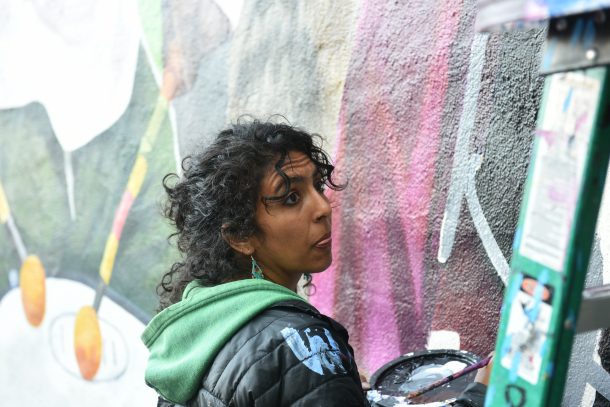
-Priya Handa
“A lot of times, I’ve heard artists say, I’m not political. Or, I don’t take a political stance. But I’ve always felt like that’s kinda not true, because once you say that sentence, you’ve already taken a political stance. ”
I remember that because, we were hitting the curfew, when it was happening. We made a decision, or my household and I made a decision not to be around someone for the sake of being immune-compromised, so it was like, hey, after this time, we go home. But it was a trip because a lot of people were coming out when we were trying to put up the pieces. So that way it was foiled, there were people planning on staying out until five am. It definitely received a lot of attention. Being someone painting but also watching how it was received, I guess a lot of people were really touched by it too. It was really beautiful to see, and see that there’s representation taking place that we don’t see. I also saw artists mobilize real quick. I saw artists put up pieces that would usually take them 4 or 5 days in like, 4-5 hours. So I think it definitely tested a lot of our skills and strengths to see what we can come up with for moments like these.
It was such a beautiful explosion of street art in Oakland. Do you feel like that changed the narrative around the protests?

Yeah. I definitely think it did. I think in so many ways. Because a lot of folks had gotten caught up with the narrative of “oh, all these damn protesters, they’re stopping business, looting, all this stuff.” So for a few days, it was crazy, all these murals were going up. You’re seeing visuals, you’re seeing colors. People are actually stepping outside, keeping social distancing but actually stepping outside and taking in this art.
In Oakland, there’s a whole tradition of political art that is community-centered, going back to Emory Douglas. Which segues to the next question: How do you see murals connecting to social movements?
I think it’s also really interesting that a lot of times, I’ve heard artists say, I’m not political. Or, I don’t take a political stance. But I’ve always felt like that’s kinda not true, because once you say that sentence, you’ve already taken a political stance. So I don’t agree with that at all. So it was really interesting to see artists actually choose a side. Because I think a lot of artists three or four years ago were not making BLM art. But now they’ve been forced to kind of choose a side and now that statement’s been made so it’s like, what’s the follow up?
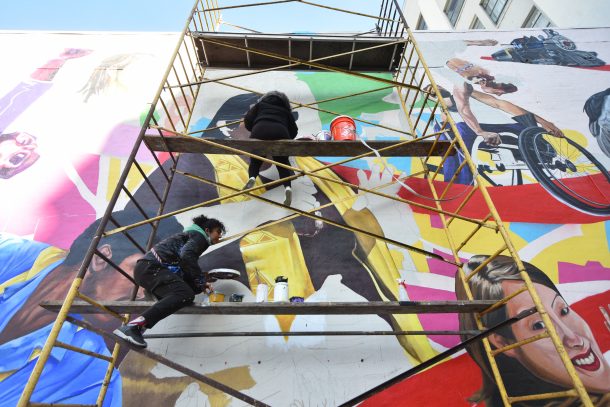
Right. Art has been used historically as a way of establishing cultural identity. Particularly in Mexico.
You know, what’s really interesting, speaking of Emory Douglas is, one time when I went to Chiapas, I ran into him. And he was like, Oh, you wanna help paint one of the murals that we’re doing? For the Comparte show or event they had. This was years ago but they had a lot of folks coming in making art. And this was for one of the murals they were doing, it was for solidarity with the Zapatistas. And they had people from Peru and Bolivia, and different parts of Mexico for sure. And he was there because he’s done a lot of work out there with them. And what was really beautiful was seeing him connect the movement of the Black Panther movement with the Zapatista movement. It meant a lot for them. But he was telling us how he took a lot from them too.
I’m noticing that as a movement grows, the way we can connect through people is through art. It’s kind of the common denominator in a lot of these movements that are international from one state to another. Because if it wasn’t for art, a lot of us would not be up in there.
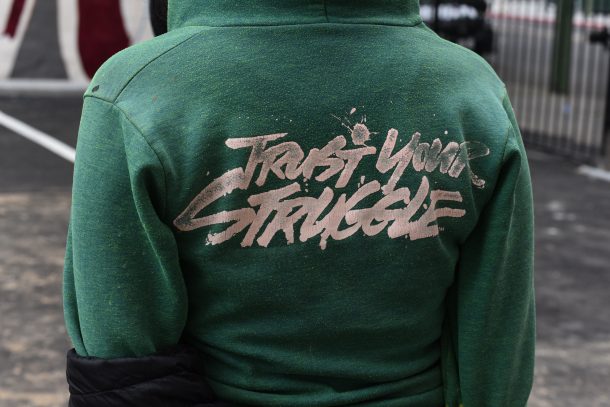
-Priya Handa
“As a movement grows, the way we can connect through people is through art.”
It was definitely beautiful to see the impact and that connection across the country. It’s definitely a way to get art up and get the word out too, right? I’ve seen folks before this movement putting up stuff for climate change. Taking up space. Art takes up space. If you’re doing mural work or doing murals on the floor, it physically takes up space. Eventually it takes up space in the system.
It becomes a commentary on the urban landscape. What else is on the urban landscape? We’ve got 37-story new developments going up. We’ve got billboards, commercial ads. And, we’ve got murals.
Definitely. Thankful for those, for sure.
Is there a philosophy to your art? Any particular aesthetic you favor?
I feel like that answer shifts and changes for me every day. I’m not the best with words but one thing I keep in mind is how the connection also with nature, as we’re having this war on folks, as we’re having this war on black bodies, we’re also experiencing a war on the earth that we just had been neglecting for so long. And we’re still not doing our job. I know for me aesthetically, I love it when the relationship with nature and earth is involved in the work that we’re doing. I definitely love to include the community in pieces as well. Because at the end of the day, we’re just translators as artists. If it’s not for other people, who else is it going to be for? Apart from that, I see it constantly evolving.
Where do you see your art taking you from here?
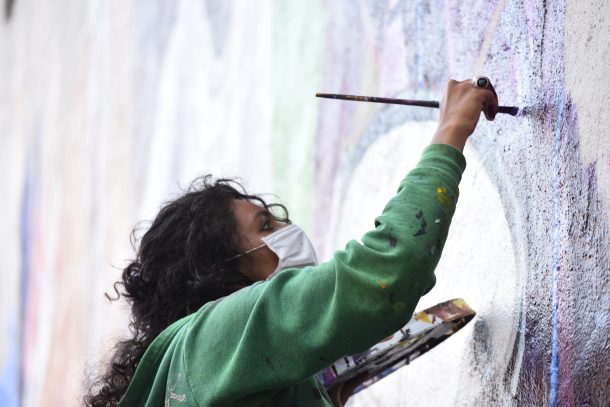
I definitely enjoy working collectively more than individually. This wall is huge, and I really hope I get to work on large walls going forward. Medium walls, large walls, and I hope to have as much intention behind them as I can, and they tell a story that isn’t told often. There’s so many situations going on all around the world we have from all of our lineages. So I hope that as we move forward and as we reclaim ourselves spiritually, our bodies and everything, the art I create helps tell those stories so they’re not forgotten.
Do you have a website? If someone wanted to commission you for a painting or a mural, what is the best way to contact you?
I took my website down because I was trying to do some edits on it. Lately I just have people who reach out to me on Instagram, which is @eightbirdz. Most of the times I’ve worked on murals it’s with people I’ve worked with before, soo it’s kind of an evolving relationship with that. In terms of pieces, usually it’ll be pieces that I’ve worked on. Sometimes I’ll take commissions, here and there.
